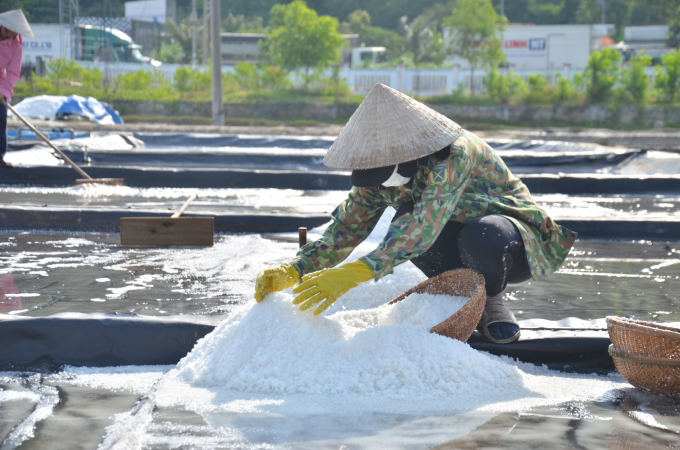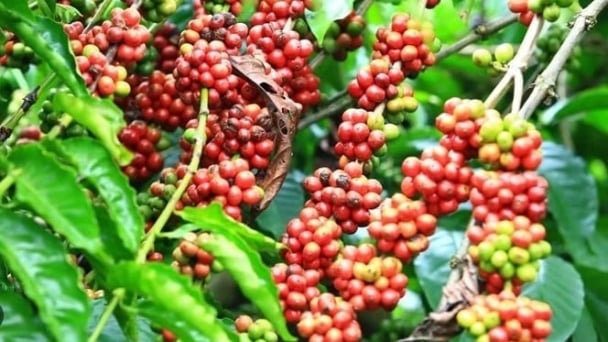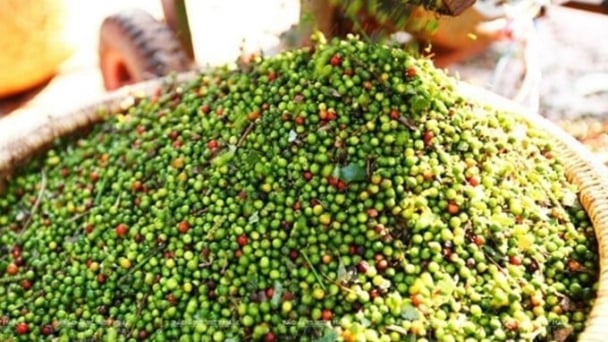April 3, 2025 | 09:40 GMT +7
April 3, 2025 | 09:40 GMT +7
Hotline: 0913.378.918
April 3, 2025 | 09:40 GMT +7
Hotline: 0913.378.918

Women working in the salt fields are a common image in in Sa Huynh (Duc Pho Town, Quang Ngai). Photo: Le Khanh.
Sa Huynh salt field is known as a famous thousand-year-old salt basin in the Central region. Sa Huynh salt product was granted a trademark registration certificate by the National Office of Intellectual Property. The salt field in the area is nearly 110 hectares wide with approximately 2,400 salt farmers belonging to 3 residential groups in Tan Diem, Thanh Duc 1 and Long Thanh 1 (Pho Thanh ward, Duc Pho town).
The erratic rise and fall of salt prices in recent years along with shifting weather conditions have challenged the salt production in Sa Huynh. The price of salt have occasionally dropped to only a few hundred dong per kilogram; as a result, many young farmers left this laborious job to find other employment opportunities. Those who remain with salt production are mainly female or older farmers who have been with the profession for a long time.
The hard work of the salt workers in the area has finally been paid off when salt prices hit a record high. Locals said that the peak was at the beginning of June, when traders bought salt in the fields at a price of up to 2,500 VND/kg, the highest price recorded in the past 10 years. Although the current price of salt has decreased slightly, it is still 3 to 4 times higher compared to the same period last year, so salt farmers are still making good profits.

The price of salt in Sa Huynh is exceptionally high this year, so salt farmers in the area are very excited. Photo: Le Khanh.
With her back drenched in sweat, Ms. Tran Thi Nho (residing in Pho Thanh Ward, Duc Pho Town) said that the price of salt is exceptionally high this year, so the locals are very happy. However, this year's productivity is not comparable to that of the previous year.
The main reason for low salt yield is weather. Under normal circumstances, each salt crop in Sa Huynh starts from March and lasts until the 8th lunar month. Presently, salt productivity is highest in May and June. However, the weather was not favorable in these two months, so the crop is lost.
“Working as a salt farmer is very laborious, I have to travel to the fields from 7 am everyday. I have to work hard, have lunch in the fields and then work until dusk. The most damaging aspect in this profession is still the rain. There were times when the salt has been dried for 2 days, ready to be harvested, but then the rain falls and the salt can't be saved, all that effort is wasted and I have to repeat for the next crop. It rained a lot this year, salt farming is disrupted, so the productivity is underwhelming. Fortunately, the price of salt is high, so each household also makes millions of dong in profit", said Ms Nho.
In the midday sun of up to 37 degrees Celsius in the Sa Huynh salt fields, hundreds of salt farmers are busy laboring away. Many of whom were hired to gather the salt in time for the trader to come and purchase. For every 50kg bag of salt, the farmer who shovels the salt is paid 2,000 VND, and the person who supports and ties the salt bag is paid 1,000 VND.

Sa Huynh salt field has an area of nearly 100 hectares, home to 2,400 salt farmers. Photo: Le Khanh.
Salt prices are high, so farmers are excited to make profits. However, salt farmers in Sa Huynh still cannot decide on the price and must depend on the trader. The common problem is that the less salt is harvested, the higher the price. On the contrary, when salt is in season, the output is high then the salt farmers control the price.
“As long as the price of salt is at 30,000 VND for a bag of 50kg or less, many farmers will leave their fields in Ho Chi Minh City to work as hired laborers, and to work odd jobs. If the government has a solution to help stabilize output and salt prices from throughout the entire salt season, farmers will feel more secure to continue working", said Mr. Phung Dinh Hoa (residing in Pho Thanh Ward, Duc Pho Town).
According to Mr. Vo Minh Vuong, Vice Chairman of Duc Pho Town People's Committee with the Sa Huynh specialty salt product, following the development plan towards 2025, Duc Pho town sets a goal for salt production to reach 12,000 tons, applying science and technology in salt production and processing, build a stable salt consumption market network, ensuring profits for salt farmers. The town has initiated a pilot model of salt production in association with rural tourism. Salt production is expected to reach over 20,000 tons by 2030.
“The town is determined to develop the salt industry in the direction of efficiency and sustainability, on the basis of taking full advantage of the traditional salt production to improve productivity, quality and diversify salt products, in order to meet consumption requirements and create employment opportunities, improve incomes, and stabilize the lives of salt farmers", said Mr. Vuong.
Translated by Nguyen Hai Long

(VAN) Pepper prices on April 2, 2025, continue to show a slight decrease domestically, with a drop of VND 1,000/kg compared to the previous trading session.

(VAN) Coffee prices on April 2, 2025, show strong fluctuations in both the global and domestic markets. Domestic coffee prices show signs of a slight decline.

(VAN) West African parboiled rice prices have fallen 25% over the past six months following India's removal of a 10% duty on exports.

(VAN) Coffee prices on April 1, 2025, continue to fluctuate. Robusta and Arabica coffee prices on the London and New York exchanges dropped.

(VAN) Pepper prices on April 1, 2025, recorded a slight decline in all key regions. Global pepper prices remained stable, with minor fluctuations.

(VAN) Total corn consumption in 2025-26 forecast at 49.8 million tonnes, up 500,000 tonnes over the previous marketing year.

(VAN) Prices of rice in Tokyo jumped around 90 percent in March from a year earlier, with the government's recent release of stockpiles having limited impact, consumer price data showed.